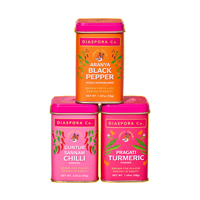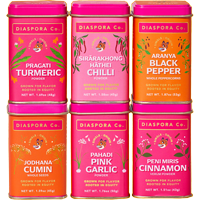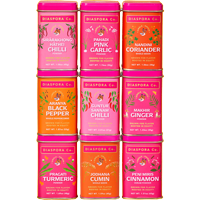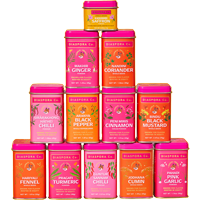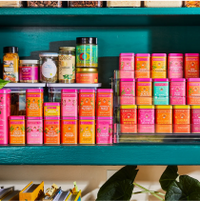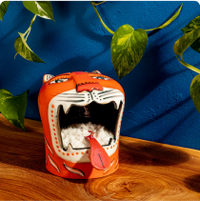As a team of heat lovers, we're smitten with chillies. In both whole and powdered forms, they hold a special place in our pantry (and our hearts). Mild and fruity, smoky with a kick, feisty and fiery, these are the spices we reach for on a daily basis (and see many of you cooking with on the reg, too!).
Since launching our first chilli, Guntur Sannam — cultivated on the Narne family farm in the historic chilli growing region of Guntur, Andhra Pradesh — in 2019, our chilli selection has expanded to a whopping six different varieties grown by our farm partners across South Asia, from Karnataka and Gujarat to Manipur and Kashmir.
Don’t know where to start with our chilli lineup, or just want to learn more about how to cook with the chillies you just received? We got you. Keep reading for all the chilli 411, from heat levels and flavor to how to use whole chillies versus powdered and our favorite recipes featuring each one.
![]()
Let’s talk whole versus powdered, frenz.
WHOLE CHILLIES
If you’re new to whole chillies, they might feel a little intimidating to start cooking with, but once you introduce yourself, we promise, you’re in for a whole new world of spicy, chilli-packed goodness!
The first step in getting to know whole chillies is understanding their flavor profiles and heat levels (don’t worry, we’ve laid out how each of our chillies taste below!). There are hundreds of chilli varieties grown across the globe — and, just like other agricultural products, each plant’s terroir, the fruit’s ripeness at harvest and preparation affect its flavor. Some chillies, like ancho, guajillo, chiles negros, and moritas, have an earthier, dried fruit taste with an almost raisiny, molasses sweetness. While others like Guntur Sannam, Resham Patti, and Kashmiri have brighter, red pepper-like flavor and notes of tomatoes and fresh, acidic fruits like pineapple and guava. And still, others, like Sirārakhong Hāthei, Sivathei, and chipotle, are smoked, adding another layer of flavor. The number of chillies out there may feel overwhelming — but, also exciting, right? — so if you’re a newbie, familiarize yourself with a couple dried, whole chillies to start and then work your way up from there.
The second step in this whole chilli journey is getting in the kitchen and learning how to cook with them. One of the most popular ways to use dried, whole chillies is to rehydrate them. This preparation transforms them from their dried form to plump and pliable, making them ideal for blending into silky sauces and salsas, as well as becoming a base for soups, stews, and braises. Here’s how to rehydrate dried, whole chillies in 3 easy steps:
- Depending on the recipe and flavor profile you’re looking for, you can use the whole chillies as-is or toast them quickly in a hot skillet for 15 to 30 seconds before rehydrating them.
- Snip off their stems with a pair of scissors or break them off with your fingers. Some chefs and cooks swear by emptying most of the seeds out of the chillies, saying that they cause bitterness, but that step is truly up to you. Much of a pepper’s heat resides in its inner ribs, so you won’t be losing too much spice by discarding the seeds.
- Once you have your prepped chillies, place them in a bowl, submerge in boiling water, cover the bowl with a plate, and allow to sit for 20 to 40 minutes, depending on their size. Now, you can pound or blend your rehydrated chillies into your desired sauce!
You can also use whole chillies straight from their dried form without rehydrating. Grind them into flavorful pastes, like this one for Massaman curry or this Hyderbadi chicken curry. Or, you can turn them into chilli flakes — the great thing about processing your own chillies is you can control the grind on them, pounding them in a mortar or blitzing them in an electric spice grinder to any size your pepper-lovin’ heart desires. Use your chilli flakes for everything, from home-fermented kimchi and spice rubs to oil-based condiments like chilli crisp and salsa macha. Our Recipe Editor, Asha, even swears by coarsely grinding Sirārakhong Hāthei chillies for pizza!
Whole chillies also love fat (hello, tadka!), adding just a kiss of heat instead of a wallop. Heat the cooking fat of your choice — Ghee! Mustard seed oil! EVOO! Bacon fat! — in a small skillet, or your tadka spoon, add a whole chilli (or break it up if it’s a big boy), and gently toast to let the chilli’s essential oils infuse into the fat. You can do this for fried eggs, spaghetti aglio e olio, gambas al ajillo, and more.
POWDERED CHILLIES
Now that we’ve taken a stroll through whole chillies, what about already ground chillies? These are just as essential to any well-stocked larder as their whole counterparts. These are the jars we reach for for ease and everyday use — the ones we rotate into our masala dabbas — because they add tons of flavor with a simple spoonful or sprinkle.
Plus, powdered chillies are often a finer grind than your average home spice grinder can achieve, making them easier to infuse into sauces, tadkas, and gravies. Their super fine texture also makes them ideal for adding vibrant color and heat to doughs of all kinds, from pasta and dumplings to focaccia and flatbreads.
Most of our powdered chillies are 100% ground chillies, but some, like Guntur Sannam, are ground with a little bit of sesame oil and salt, which help get them to just the right size and texture. With chillies that are ground with other ingredients, like salt, however miniscule, make sure to adjust your seasoning accordingly when you are cooking with them.
But, at the end of the day, there are no hard and fast rules when it comes to cooking with dried chillies. Have fun and find combinations and dishes you love — and, if you need a little inspo, check out our Recipes section, chock-full of chilli recipes, all searchable by varietal.
![]()
Meet our cute lil chilli lineup.
Resham Patti
Shedubhar, Gujarat

These oblong, plump, bright red chillies — grown on the Sakariya family farm, intercropped with everyone's favorite Nandini Coriander — are the mildest of the Diaspora bunch with very little heat, lots of fruit-forward flavor, a delicate tanginess akin to tamarind, and an almost tomato ketchup-like taste when rehydrated and blended. They are our go-to for red enchilada sauce, birria, and as a base for homemade hot sauces and chutneys. Available in dried, whole chilli form only.
I’m new to chillies: Try this all-purpose, 8-ingredient Smoky Red Chile Sauce.
I’m ready to level up: Get your ferment on with this Baechu Kimchi.
![]()
Byadgi
Gadag, Karnataka

These almost neon, crimson-hued chillies — the Dyavanur Dabbi variety of Byadgi Chillies, grown by B.S. Patil, in Gadag, Karnataka — have a vibrant red pepper flavor with earthy, rich notes of dried mushrooms and a subtle heat that weaves its way through whatever you add them to. They’re an integral ingredient in many fish and seafood dishes across South India, but their mild spice and crisp, almost bell pepper taste make Byadgi chillies a great substitute for sweet paprika in your favorite recipes. Available in dried, powdered chilli form only. Available in powdered chilli form only.
I’m new to chillies: Make a zesty chilli popcorn seasoning! Combine 2 tablespoons nutritional yeast with 1 teaspoon powdered Byadgi Chillies (or the chilli of your choice), ½ teaspoon sea salt, ¼ teaspoon Pragati Turmeric, and the zest of 1 lime in a spice grinder, and blend into a fine powder. Toss with hot, buttered popcorn and enjoy!
I’m ready to level up: Whip up Ann Ittop’s Kerala Fish Curry.
![]()
Guntur Sannam
Guntur, Andhra Pradesh

The OG Diaspora chilli, Guntur Sannam — grown by brothers Hanumantharao and Satyanarayana Rao — has a sunny, bright flavor bursting with notes of lemon, sumac and tomato skin, and a mild-to-medium, building heat.
The powdered version of these famed chillies are ground with a little sesame oil and a touch of salt — amping up their chilli flavor and making them even more delicious — into a medium fine powder. The whole, dried Guntur Sannam chillies are a favorite for tadka, hot sauces, and a wonderful addition to a pot of beans or braised greens. Available in both dried, whole and powdered forms.
I’m new to chillies: Sprinkle the powdered Guntur Sannam chillies over halves of jammy-yolked, 6-minute eggs; use to garnish dips & spreads; or, use in a sweet-hot-tangy rim for Pineapple Mezcalitas with Sumac & Chilli. The whole chillies are tadka’s best friend!
I’m ready to level up: Dive into a potful of Archana Pidathala’s Guntur-Chile Chicken.
![]()
Sirārakhong Hāthei
Sirārakhong, Manipur

Since launching in spring 2021, Sirārakhong Hāthei chillies — grown by a cooperative of young farmers from the village of Sirārakhong and sourced by Zeinorin & Alan of Hillwild — have become the darling of our chilli selection, loved by our team and YOU in equal enthusiasm! These long, brick-red chillies — smoked on bamboo mats over low, wood-burning fires — are umami-rich with deep notes of bacon, oak, and whiskey, and a medium heat.
A classic mate for pork, powdered Sirārakhong Hāthei chillies transform braised pork belly into something magical with just salt and water. They also add smoky brilliance to ragù, homemade sausages, and BBQ spice rubs and marinades. The whole chillies add depth and smoke to any tadka, and are perfect for hot sauces, salsas, and chutneys. Available in both dried, whole and powdered forms.
I’m new to chillies: Add powdered Sirārakhong Hāthei to tomato sauces of any kind; bloom in butter before frying an egg; or, use to make the simplest, most lip-smackingly good, 4-ingredient braised pork (a recipe from Zeino herself!).
I’m ready to level up: Add a little smokiness to Massaman Curry paste, pairing the whole Sirārakhong Hāthei with Resham Patti or Guntur Sannam chillies.
![]()
Kashmiri
Pulwama, Kashmir

Grown by the Farukh family on their ancestral land in Pulwama in the Kashmir valley, this is true Kashmiri mirch. Deep scarlet in color, these chillies bring the flavor on so many levels with sweet notes of prune and pineapple, a touch of bright acidity (hello, citrus aroma!), and a whisper of rich, salinity akin to tamari, plus a medium-to-hot heat that’ll sneak up on ya.
The powdered version of this chilli is as versatile as it is delicious, bringing both vibrant color and incredible chilli taste to a variety of dishes, including Kashmiri favorites rogan josht and nadru yakhni (lotus root cooked in yogurt gravy). Kashmiri chilli’s nuanced red pepper flavor and gentle, fiery kick make it a great substitute for hot paprika in recipes. The whole chillies are wildly tasty in homemade hot sauces paired with either Resham Patti chillies for a milder, fruity hot sauce or a couple Sivathei chillies for a smokier, spicier hot sauce. Available in both dried, whole and powdered forms.
I’m new to chillies: Make chilli tamarind rice! Start by soaking a golf ball size piece of tamarind in ½ cup of hot water for 15 minutes. Strain the tamarind into a 2-cup measuring cup and then fill to the 2-cup mark with cold water. In a medium saucepan, combine 1 cup rice of your choice with the tamarind water, ½ teaspoon salt, ½ teaspoon powdered Kashmiri Chillies. Cover, bring to a boil, and then cook on low until the rice is done (time will vary depending on what rice you’re using). Let sit covered for 5 minutes and enjoy
I’m ready to level up: Make the GOAT Kashmiri chilli dish: Rogan Josht.
![]()
Sivathei
Chahong, Manipur

Known by many different names across Northeast India — Bhut Jholokia, Naga Mirch, King Chilli, Umorok, just to name a few — we chose to name this wildly spicy pepper by its Tangkhul name of Sivathei because the Hillwild team who sources it for us are all proud members of the Tangkhul tribe.
While the Sivathei chilli sits at a 5 on our heat scale, it is infinitely hotter than all our other chillies (we’re talking about the 7th hottest chilli in the world!). Like Hillwilds’s other Manipuri-grown chilli, Sirārakhong Hāthei, the Sivathei chillies are smoked on bamboo mats over wood fires, imbuing them with an intoxicating fruity, smoky fragrance. The big, bold heat of these chillies is balanced by an equally bold flavor with sweet notes of maple and guava.
These chillies are often used in simple chutneys by pounding one rehydrated chilli with salt and a little garlic, and then adding an extender like boiled potatoes, tomatoes, or herbs. This condiment brings mouthwatering heat and lots of fire to anything it's served with — we love it paired with dal of any kind, Zeino’s braised pork, slow-cooked beans, and so much more. Available in dried, whole chilli form only.
I’m new to chillies: Add ½ or 1 whole Sivathei chilli to a pot of beans, removing halfway through cooking (this little baby is SPICY, so you want to make sure no one gets a big bite).
I’m ready to level up: Dig into Asha’s Manipuri Hot Chicken.









